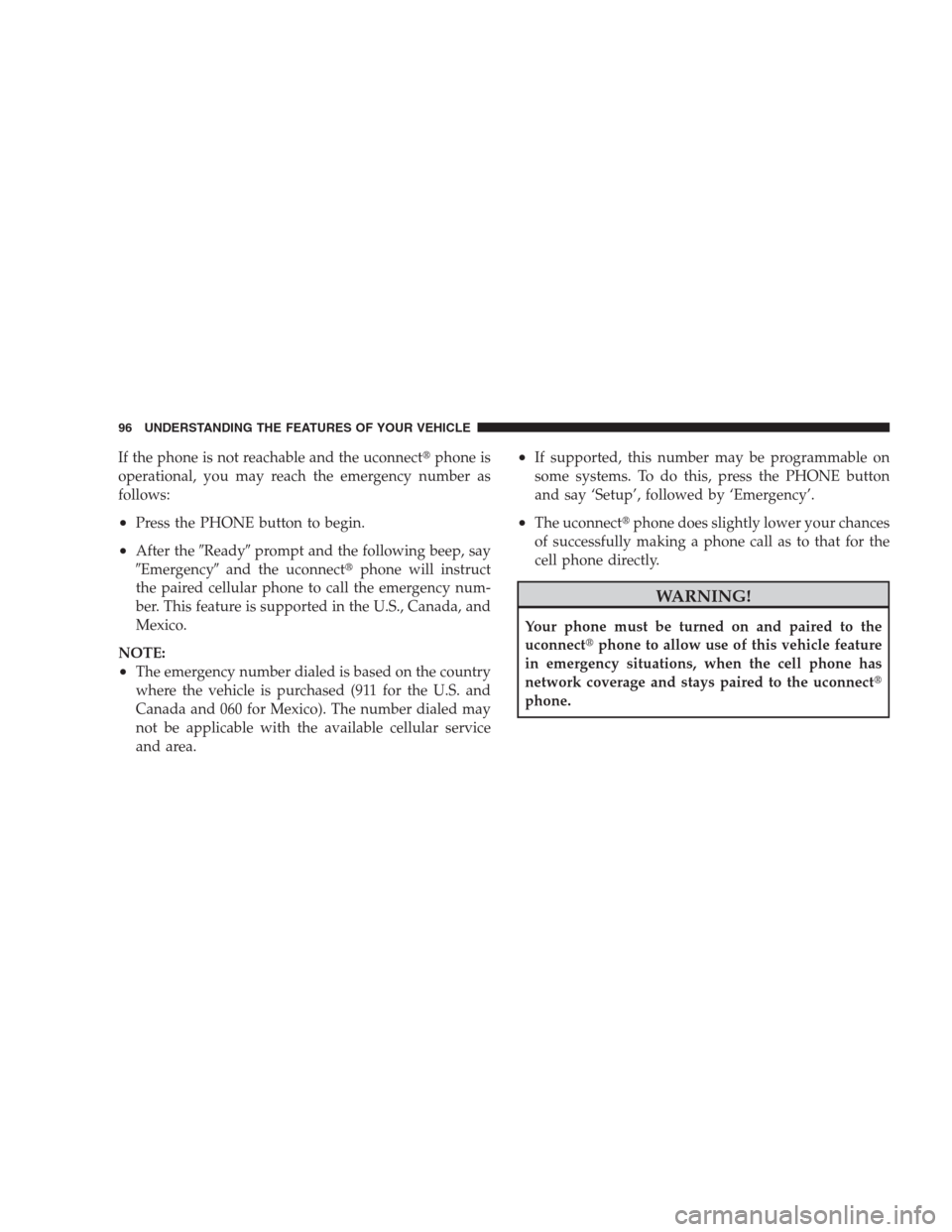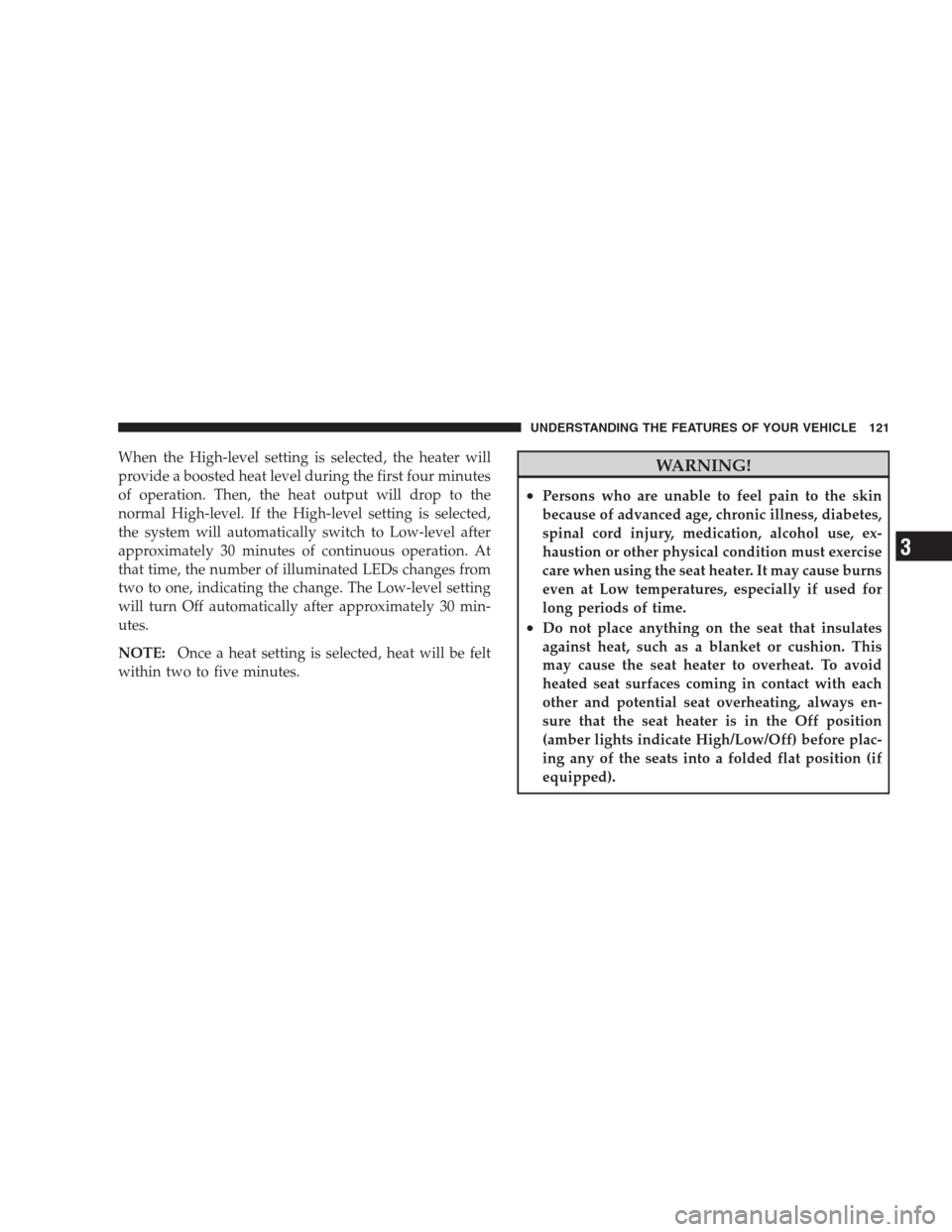Page 58 of 521

Airbag Warning Light
You will want to have the airbag system ready to inflate
for your protection in an impact. The airbag system is
designed to be maintenance free. If any of the following
occurs, have an authorized dealer service the system
promptly:
•Airbag Warning Light does not come on during the six
to eight seconds after the ignition switch is first turned
on,
•Remains on after the six to eight second interval, or
•Flickers, or comes on and remains on for any period of
time while driving.
NOTE:If the speedometer, tachometer, or any engine
related gauges are not working, the airbag control mod-
ule may also be disabled. The airbags may not be ready
to inflate for your protection. Promptly check the fuseblock for blown fuses. Refer to “Fuses” in Section 7 of this
manual. See your authorized dealer if the fuse is good.
Event Data Recorder (EDR)
In the event of an accident, your vehicle is designed to
record up to five seconds of specific vehicle data param-
eters (see the following list) in an event data recorder
prior to the moment of airbag deployment, or near
deployment, and up to one-quarter second of high-speed
deceleration data during and/or after airbag deployment
or near-deployment. EDR data are ONLY recorded if an
airbag deploys, or nearly deploys, and are otherwise
unavailable.
NOTE:
•A near-deployment event occurs when the airbag
sensor detects severe vehicle deceleration usually in-
dicative of a crash, but not severe enough to warrant
airbag deployment.
56 THINGS TO KNOW BEFORE STARTING YOUR VEHICLE
Page 73 of 521

Airbag Warning Light
The light should come on and remain on for six to eight
seconds as a bulb check when the ignition switch is first
turned ON. If the light is not lit during starting, see your
authorized dealer. If the light stays on, flickers, or comes
on while driving, have the system checked by an autho-
rized dealer.
Defroster
Check operation by selecting the defrost mode and place
the blower control on high speed. You should be able to
feel the air directed against the windshield. See your
authorized dealer for service if your defroster is
inoperable.
Periodic Safety Checks You Should Make Outside
The Vehicle
Tires
Examine tires for excessive tread wear and uneven wear
patterns. Check for stones, nails, glass, or other objectslodged in the tread. Inspect the tread and sidewall for
cuts and cracks. Check the wheel nuts for tightness.
Check the tires (including spare) for proper pressure.
Lights
Have someone observe the operation of exterior lights
while you work the controls. Check turn signal and high
beam indicator lights on the instrument panel.
Door Latches
Check for positive closing, latching, and locking.
Fluid Leaks
Check area under vehicle after overnight parking for fuel,
engine coolant, oil, or other fluid leaks. Also, if gasoline
fumes are detected or if fuel, power steering fluid, or
brake fluid leaks are suspected, the cause should be
located and corrected immediately.
THINGS TO KNOW BEFORE STARTING YOUR VEHICLE 71
2
Page 78 of 521

▫To Resume Speed.................... 146
▫To Vary The Speed Setting.............. 146
▫To Accelerate For Passing.............. 147
�Rear Park Assist — If Equipped........... 147
▫Rear Park Assist Sensors............... 147
▫Rear Park Assist Warning Display........ 148
▫Enable/Disable The Rear Park Assist...... 150
▫Service The Rear Park Assist............ 150
▫Cleaning The Rear Park Assist........... 151
�Rear Camera — If Equipped.............. 151
▫Turning The Rear Camera On Or Off — With
Navigation Radio.................... 152
▫Turning The Rear Camera On Or Off —
Without Navigation Radio.............. 152�Overhead Console..................... 153
▫Courtesy/Reading Lights.............. 153
▫Sunglasses Storage................... 154
�Garage Door Opener — If Equipped........ 154
▫Programming HomeLink�.............. 155
▫Gate Operator/Canadian Programming.... 158
▫Using HomeLink�................... 158
▫Reprogramming A Single
HomeLink�Button................... 159
▫Security........................... 159
▫Troubleshooting Tips.................. 159
▫General Information.................. 160
�Power Sunroof — If Equipped............ 160
76 UNDERSTANDING THE FEATURES OF YOUR VEHICLE
Page 81 of 521
CAUTION!
To avoid damage to the mirror during cleaning, never
spray any cleaning solution directly onto the mirror.
Apply the solution onto a clean cloth and wipe the
mirror clean.
Outside Mirrors
To receive maximum benefit, adjust the outside mirrors
to center on the adjacent lane of traffic with a slight
overlap of the view obtained on the inside mirror.
WARNING!
Vehicles and other objects seen in the passenger side
convex mirror will look smaller and farther away
than they really are. Relying too much on your
passenger side convex mirror could cause you to
collide with another vehicle or other object. Use your
inside mirror when judging the size or distance of a
vehicle seen in the passenger side convex mirror.
Some vehicles will not have a convex passenger side
mirror.
Automatic Dimming Mirror
UNDERSTANDING THE FEATURES OF YOUR VEHICLE 79
3
Page 98 of 521

If the phone is not reachable and the uconnect�phone is
operational, you may reach the emergency number as
follows:
•Press the PHONE button to begin.
•After the�Ready�prompt and the following beep, say
�Emergency�and the uconnect�phone will instruct
the paired cellular phone to call the emergency num-
ber. This feature is supported in the U.S., Canada, and
Mexico.
NOTE:
•The emergency number dialed is based on the country
where the vehicle is purchased (911 for the U.S. and
Canada and 060 for Mexico). The number dialed may
not be applicable with the available cellular service
and area.
•If supported, this number may be programmable on
some systems. To do this, press the PHONE button
and say ‘Setup’, followed by ‘Emergency’.
•The uconnect�phone does slightly lower your chances
of successfully making a phone call as to that for the
cell phone directly.
WARNING!
Your phone must be turned on and paired to the
uconnect�phone to allow use of this vehicle feature
in emergency situations, when the cell phone has
network coverage and stays paired to the uconnect�
phone.
96 UNDERSTANDING THE FEATURES OF YOUR VEHICLE
Page 122 of 521
WARNING! (Continued)
•Do not place anything on the seat that insulates
against heat, such as a blanket or cushion. This
may cause the seat heater to overheat. To avoid
heated seat surfaces coming in contact with each
other and potential seat overheating, ALWAYS
ensure that the seat heater is in the Off position
(amber lights indicate High/Low/Off) before plac-
ing any of the seats into a folded flat position (if
equipped).
Rear Heated Seats — If Equipped
On vehicles equipped with rear heated seats, the seats
closest to the doors are heated. The controls for these
seats are located on the rear of the center console.Press the switch once to select High-level heat-
ing. Press the switch a second time to select
Low-level heating. Press the switch a third time
to shut the heating elements Off. Two indica-
tors will illuminate for High, one for Low, and none for
Off.Rear Heated Seat Switches
120 UNDERSTANDING THE FEATURES OF YOUR VEHICLE
Page 123 of 521

When the High-level setting is selected, the heater will
provide a boosted heat level during the first four minutes
of operation. Then, the heat output will drop to the
normal High-level. If the High-level setting is selected,
the system will automatically switch to Low-level after
approximately 30 minutes of continuous operation. At
that time, the number of illuminated LEDs changes from
two to one, indicating the change. The Low-level setting
will turn Off automatically after approximately 30 min-
utes.
NOTE:Once a heat setting is selected, heat will be felt
within two to five minutes.WARNING!
•Persons who are unable to feel pain to the skin
because of advanced age, chronic illness, diabetes,
spinal cord injury, medication, alcohol use, ex-
haustion or other physical condition must exercise
care when using the seat heater. It may cause burns
even at Low temperatures, especially if used for
long periods of time.
•Do not place anything on the seat that insulates
against heat, such as a blanket or cushion. This
may cause the seat heater to overheat. To avoid
heated seat surfaces coming in contact with each
other and potential seat overheating, always en-
sure that the seat heater is in the Off position
(amber lights indicate High/Low/Off) before plac-
ing any of the seats into a folded flat position (if
equipped).
UNDERSTANDING THE FEATURES OF YOUR VEHICLE 121
3
Page 132 of 521
WARNING!
If the hood is not fully latched, it could fly up when
the vehicle is moving and block your forward vision.
Be sure all hood latches are fully latched before
driving.
LIGHTS
Multifunction Lever
The multifunction lever controls the operation of the
headlights, turn signals, headlight beam selection, instru-
ment panel light dimming, passing light, interior
courtesy/dome lights, and optional fog lights. The mul-
tifunction lever is located on the left side of the steering
wheel.
Headlights and Parking Lights
Turn the end of the multifunction lever to the first detent
for parking light operation. Turn to the second detent for
headlight operation. Turn to the third detent for AUTO
headlight operation (if equipped).
Headlight Switch
130 UNDERSTANDING THE FEATURES OF YOUR VEHICLE